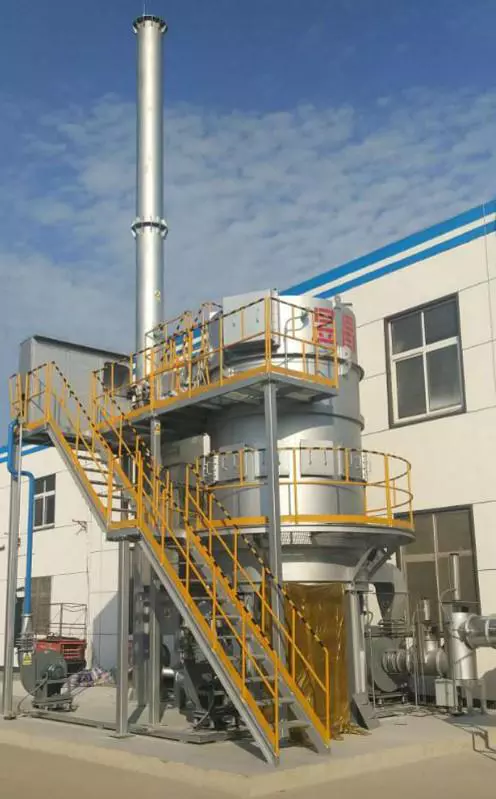Recuperative Thermal Oxidizer for Biogas
Biogas is a renewable energy source that is produced from organic materials such as agricultural waste, food waste, and sewage. It is a clean-burning fuel that can be used to generate electricity and heat. However, biogas also contains impurities such as volatile organic compounds (VOCs), hydrogen sulfide (H2S), and siloxanes that can be harmful to the environment and human health if released into the atmosphere.
What is a Recuperative Thermal Oxidizer?
A recuperative thermal oxidizer is a type of air pollution control equipment that is used to treat industrial emissions containing pollutants such as VOCs and H2S. It works by heating the emissions to a high temperature in a combustion chamber, where the pollutants are oxidized into carbon dioxide and water vapor. The heat generated from the combustion process is then transferred to a heat exchanger, which is used to preheat the incoming emissions and reduce the energy required to maintain the high temperature in the combustion chamber.
How does a Recuperative Thermal Oxidizer work for Biogas?
A recuperative thermal oxidizer can be used to treat the emissions from biogas production facilities. The biogas is first cleaned and dried to remove impurities such as moisture and siloxanes. The purified biogas is then burned in the combustion chamber of the thermal oxidizer, where it is oxidized into carbon dioxide and water vapor. The heat generated from the combustion process is transferred to a heat exchanger, where it is used to preheat the incoming biogas and reduce the energy required to maintain the high temperature in the combustion chamber. The preheated biogas is then sent to a generator to produce electricity and heat.
Advantages of Recuperative Thermal Oxidizer for Biogas
- High efficiency in removing pollutants from biogas emissions.
- Low operating costs due to the energy savings from the heat exchanger.
- Compliance with environmental regulations and standards.
- Reduction in greenhouse gas emissions.
- Flexible design that can be customized to meet specific requirements.
Applications of Recuperative Thermal Oxidizer for Biogas
Recuperative thermal oxidizers can be used in various industries that produce biogas, including:
- Agriculture
- Food and beverage
- Sewage treatment
- Waste management
They can also be used to treat emissions from other sources, such as:
- Chemical manufacturing
- Pharmaceuticals
- Petrochemicals
- Paints and coatings
Recuperative thermal oxidizers are a reliable and effective solution for reducing the environmental impact of biogas production and other industrial processes. They offer high efficiency in removing pollutants, low operating costs, and compliance with environmental regulations and standards. By using recuperative thermal oxidizers, industries can reduce their carbon footprint and contribute to a cleaner, healthier planet.

公司簡介
We are a high-tech enterprise that specializes in comprehensive treatment of volatile organic compounds (VOCs) and carbon reduction energy-saving technology. Our company has four core technologies in thermal energy, combustion, sealing, and automatic control. We have the ability to simulate temperature fields, air flow fields, and have the capacity to test the properties of ceramic heat storage materials, molecular sieve adsorption materials and VOCs organic high-temperature incineration oxidation. Our R&D and technical centers are located in Xi’an and Yangling, with a production base of 30,000 square meters. We are the leading manufacturer of RTO equipment and molecular sieve rotary equipment in the world. Our core technology team comes from the Aerospace Liquid Rocket Engine Research Institute (Aerospace Sixth Institute). We have over 360 employees, including over 60 R&D technology backbones, three senior engineers at the researcher level, six senior engineers, and 60 thermodynamics doctors.
Recognitions and Qualifications
Our company has obtained various certifications and qualifications, such as knowledge management system certification, quality management system certification, environmental management system certification, construction industry enterprise qualification, high-tech enterprise, rotating valve-type heat storage oxidation furnace (RTO) patent, rotary-wing heat storage incinerator equipment patents, disc-type molecular sieve rotary patents, etc.

How to Choose the Right RTO Equipment
Choosing the right RTO equipment requires several steps:
- Determine the characteristics of the waste gas;
- Understand local regulations and emission standards;
- Evaluate energy efficiency;
- Consider operation and maintenance;
- Analyze budget and costs;
- Select the appropriate RTO type;
- Consider environmental and safety factors;
- Perform performance testing and verification.
It is essential to explain each of these points in detail to ensure the right RTO equipment is selected.

服務流程
Our service process includes:
- Consultation and evaluation: preliminary consultation, on-site inspection, and demand analysis;
- Design and solution development: scheme design, simulation and modeling, and scheme review;
- Production and manufacturing: customized production, quality control, and factory testing;
- Installation and commissioning: on-site installation, commissioning, and training services;
- After-sales support: regular maintenance, technical support, and spare parts supply.
We pride ourselves on offering a one-stop solution, with a team of professionals that can tailor an RTO solution to meet our clients’ needs.
作者:米婭
